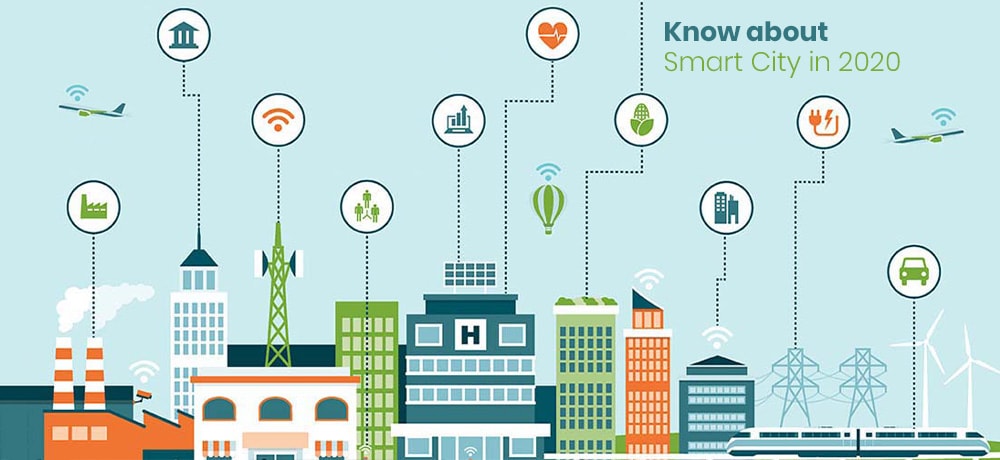A smart city is an urban locality or a city where the infrastructure and operations are interlinked and connected to the IoT network through various devices and sensors. The system helps collect and analyze data and leverage the insights from this information to efficiently manage resources and services.
It is a framework of IoT and Information and Communication Technologies (ICT) that aims at improving the efficiency of city operations and services. The smart city ecosystem also helps the citizens, their homes, and vehicles to connect to city services using mobile devices.
The global smart city market is expected to grow over USD 158 billion by 2022 (Source) and to a huge USD 1.56 trillion by 2025 (Source).
Smart Cities – Why and How?
A smart city focuses on the life and needs of citizens and helps solve challenges resulting from growing urbanization. Smart cities make it possible to cut costs and improve environmental, social, and economic sustainability by connecting devices and data with the city’s infrastructure and services.
This data is processed and analyzed on the smart city IoT network to monitor and efficiently manage utilities, traffic & transportation systems, water supply, power plants, waste management, information systems, crime detection, schools, hospitals, and more. This helps governing authorities and citizens make better decisions, decrease traffic congestion, enhance air quality, improve energy distribution, streamline trash collection, etc.
Today, there are numerous smart cities across the globe. Singapore is officially ranked the smartest city in 2019 by the very first edition of the IMD Smart City Index 2019 (Source).
Copenhagen is another popular smart city with multiple smart city initiatives in place for residents including the Danish Outdoor Lighting Lab (DOLL) that offers 40 outdoor light solutions along with multiple parking, waste, and environmental sensing solutions spreading over more than 10-km stretch of road. DOLL also provides data to the city authorities to identify and target the sources of pollution (Source).
Top Elements or Features of a Smart City
Numerous smart-city initiatives or ideas are being adopted worldwide. Here are the common elements or necessary features that collectively make a city smart!
1. Wireless Connectivity
A reliable wireless network to a smart city is what the root means to a tree! The most important or central element of a smart city ecosystem is reliable wireless connectivity. This is commonly achieved using low-power wide-area networks (LPWAN).

This connects all other elements or smart systems of a smart city and ensures their efficient use by citizens and authorities. A city cannot be “smart” without a well-functioning, high-speed wireless network.
2. Smart Traffic Management
Smart infrastructure includes various smart facilities that add security and comfort to citizens of a smart city, the most important being smart traffic management. A recent study by Juniper Research suggests that smart city traffic technology solutions will generate USD 4.4 billion in revenue in 2023 (Source).
Smart traffic management includes traffic monitoring/control, optimizing routes, tracking vehicles, reducing pollution, accident detection, preventing jams, and more.
Historical traffic data and data collected through on-road sensors are used to identify congestion areas, timings, and patterns. This can help control traffic in such spots during peak hours by restricting vehicles from other cities during these hours. Smart parking meters can help drivers locate available parking spaces in different areas with ease.
For example, traffic lights automatically operate based on data received from sensors and vehicles in response to real-time traffic conditions. Self-driving or autonomous vehicles are used to eliminate human-error related collisions in smart cities.
Another smart initiative in traffic management of smart cities is the use of sensors for monitoring and detection of accident-prone areas and an automated system to alert citizens to avoid these areas temporarily. Besides, there are sensors to provide alerts and warnings to relevant authorities and people about natural calamities such as earthquakes, floods, landslides, etc.
3. Smart Lighting
A smart lighting system offers remote lighting management and control of connected streetlights with demand-based lighting. The system ensures the right illumination levels throughout the city as required, with sensors detecting and sending information about the illumination needs. This helps save electricity to a large extent.
For example, lighting on internal streets or less used streets is dimmed during mid-night hours and automatically brightened when vehicles or people are sensed. Besides, these streetlights are mounted with sensors for additional smart objectives like accident detection.
4. Robust Network Security
A significant element of a smart city ecosystem is efficient security and data privacy measures in place. The system restricts connection or access to the smart city devices, city data, and IoT network from unauthorized elements.

The smart city network needs to be secure, but this is a challenge as there are numerous devices connected to the smart city IoT network. To ensure security, there are strict network security rules, strong access controls, and a firewall security system to prevent access to sensitive systems and safe password practices.
The system should be well-tested through breach simulation or penetration testing. The system should be able to automatically scan network activities and identify suspicious internet traffic to counter attacks.
Overall, a smart city has required automated systems in place to identify a breach, contain the attack, and restore the systems. Besides, it should be well-equipped to alert the relevant officials about the possible breach through ML and AI.
5. Fire Safety and Management
Smart cities have a smart fire management system to include smart fire sensors to detect and automatically respond with appropriate measures as needed.
For example, in case of a major fire break-out, the sensors detect and send alerts to inform firefighters and ambulance. There are automated systems in place to help evacuation of people, putting rescue operations into action, activating robots for rescue, and informing relevant authorities or officials.
6. Intelligent Waste Management
A smart city cannot be “smart” or complete without a smart waste management system. Proper waste management keeps the city clean and the citizens healthy. Waste management includes waste collection, separating recyclable waste, recycling, and disposal of non-recyclable waste. Smart waste management aims at making these activities efficient for citizens and officials by saving cost and time.
The basic requirement of a waste management system is an automatic trash collection system. For example, trash bins with sensors can detect when the bin is about to get full and needs to be emptied. This information is then sent to the smart city network and gets added to the route and schedule of collection trucks automatically for collection.
Another significant example is the smart city, Seoul that utilizes solar-powered trash compaction to increase the waste holding capacity of bins, thus reducing the costs incurred in the waste collection process.
AI-enabled smart waste management system separates recyclable waste and routes it to the recycling unit. This saves a lot of time and money for the officials.
7. Smart Water Management
Another important element of smart cities is the smart water management system to include smart planning, distribution, management, and use of water.

Smart water management ensures an optimum supply of potable water to homes and automatic monitoring of leakages in water storage and informing the same to relevant authorities for repair. Apart from the supply, the system also monitors water contamination and chemical contamination of rivers.
Smart water management devices include meters and sensors for monitoring consumption, leakage detection through pressure monitoring, water quality monitoring, water/sewage treatment plants, and more.
For example, smart automated water meters in New York City send daily consumption readings to the computerized billing system (Source).
8. Smart Healthcare
Smart cities must offer smart healthcare solutions for residents to include monitoring patients’ health and informing the same to doctors in real-time to assure quick and systematic access to medical facilities. AI-based apps can monitor the condition of patients and assist in medical consultation by connecting the patient to an appropriate medical facility or practitioner.
For example, in case of medical emergencies or accidents, the smart system can automatically notify the ambulance.
9. Environmental Concerns and Energy Conservation
Smart cities ultimately aim at energy conservation and solving environmental concerns by optimum use of resources and energy saving. Smart city initiatives help reduce pollution and derive alternative environment-friendly solutions that offer a healthy environment for citizens.
For example, smart streetlights incorporate sensors for collecting traffic data and are equipped with surveillance cameras too to assure the safety of citizens. Smart cities also utilize solar panels to leverage solar energy and offer all facilities to promote electric vehicles to save fuel and control pollution.
10. Smart Buildings
Smart buildings have facility automation and safety systems in place. These commonly include sensors in buildings to detect damages and inform the officials for repairs. Security systems are well-connected to take appropriate measures automatically on detecting any security breach. The system even notifies the officials who can then take appropriate action with this prompt information.

For example, smart HVAC systems use various sensors to detect occupancy, temperature, humidity, pressures, electricity consumption, gas consumption, water usage, air quality, etc. This data is utilized to automatically shut down the relevant systems like power, etc. when the building unit is not in use. The system also helps inform the authorities about air quality so that appropriate measures can be taken to improve the same.
11. Smart Citizens and Governance
Smart cities enable citizens to stay well connected to operations and services. Smart homes and cars are all connected to the city’s network and help share useful information between citizens and authorities. Thus, smart cities connect citizens and governance, helping the authorities perform better.
Citizens in smart cities can enjoy a “smart” and comfortable life as they can access information about energy consumption, find public transport, and even pay bills on apps.
For example, Singapore’s smart city initiatives include CODEX (Core Operations Development Environment and eXchange), a digital platform that enables the government to deliver faster and more cost-efficient digital services to citizens (Source). This platform also helps public and private sectors to work in collaboration and develop more user-centric services for the residents of smart city, Singapore.
Wrapping Up
Smart cities aim at planned development and are a step towards a better future. These are meant to improve the lives of citizens and help authorities or governance perform better with ease.
Technologies (including IoT, ML, AI, and more) are used to improve urban facilities. A city that leverages multiple forms of technology to improve and connect multiple areas or facilities becomes a smart city. Economies worldwide are generating new smart city ideas each-day and the definition of a smart city varies based on the financial and technological capabilities of these nations.
There are apprehensions too surrounding the efficacy of smart cities across the globe, but as said by Jakob Julian Nurnberger,
“The smart city is a gift, a chance to transform old and slow systems and structures into a smart future”.
So, let’s adopt the smart city initiative, taking advantage of the positives it offers and resolving the negatives if any, and help it improve our lives and future!






